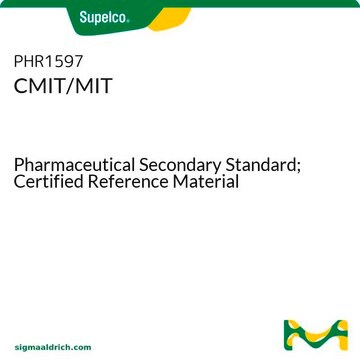46078
2-Octyl-4-isothiazolin-3-one
PESTANAL®, analytical standard
Synonyme(s) :
2-Octyl-3(2H)-isothiazolone, Octhilinone
About This Item
Produits recommandés
Qualité
analytical standard
Gamme de produits
PESTANAL®
Durée de conservation
limited shelf life, expiry date on the label
Application(s)
agriculture
environmental
Format
neat
Chaîne SMILES
CCCCCCCCN1SC=CC1=O
InChI
1S/C11H19NOS/c1-2-3-4-5-6-7-9-12-11(13)8-10-14-12/h8,10H,2-7,9H2,1H3
Clé InChI
JPMIIZHYYWMHDT-UHFFFAOYSA-N
Vous recherchez des produits similaires ? Visite Guide de comparaison des produits
Catégories apparentées
Application
- Nonthermal Plasma in Wastewater Treatment: This research utilized nonthermal plasma-based advanced oxidation processes (AOPs) for degrading micropollutants, including isothiazolinones, in wastewater. The study underscores the effectiveness of 2-Octyl-4-isothiazolin-3-one in microbial growth control, providing insights into its applications in wastewater management and microbial contamination control (Chen et al., 2023).
- Surface Interactions of Semi-Volatile Isothiazolinones: The study quantified the equilibria of semi-volatile isothiazolinones, such as 2-Octyl-4-isothiazolin-3-one, between air and glass surfaces, using techniques like gas chromatography and Raman spectroscopy. This research is vital for understanding the stability and persistence of 2-Octyl-4-isothiazolin-3-one in various environments, particularly its use in biotech applications (Sohn et al., 2023).
Informations légales
Mention d'avertissement
Danger
Mentions de danger
Classification des risques
Acute Tox. 2 Inhalation - Acute Tox. 3 Dermal - Acute Tox. 3 Oral - Aquatic Acute 1 - Aquatic Chronic 1 - Eye Dam. 1 - Skin Corr. 1B - Skin Sens. 1A
Risques supp
Code de la classe de stockage
6.1A - Combustible acute toxic Cat. 1 and 2 / very toxic hazardous materials
Classe de danger pour l'eau (WGK)
WGK 3
Point d'éclair (°F)
Not applicable
Point d'éclair (°C)
Not applicable
Équipement de protection individuelle
Faceshields, Gloves, Goggles, type ABEK (EN14387) respirator filter
Certificats d'analyse (COA)
Recherchez un Certificats d'analyse (COA) en saisissant le numéro de lot du produit. Les numéros de lot figurent sur l'étiquette du produit après les mots "Lot" ou "Batch".
Déjà en possession de ce produit ?
Retrouvez la documentation relative aux produits que vous avez récemment achetés dans la Bibliothèque de documents.
Les clients ont également consulté
Notre équipe de scientifiques dispose d'une expérience dans tous les secteurs de la recherche, notamment en sciences de la vie, science des matériaux, synthèse chimique, chromatographie, analyse et dans de nombreux autres domaines..
Contacter notre Service technique












